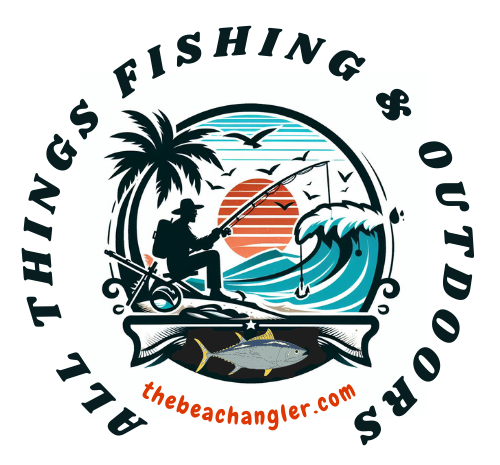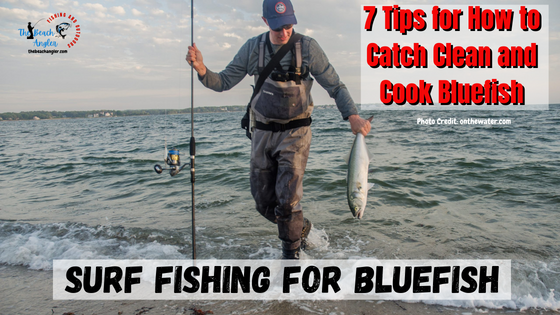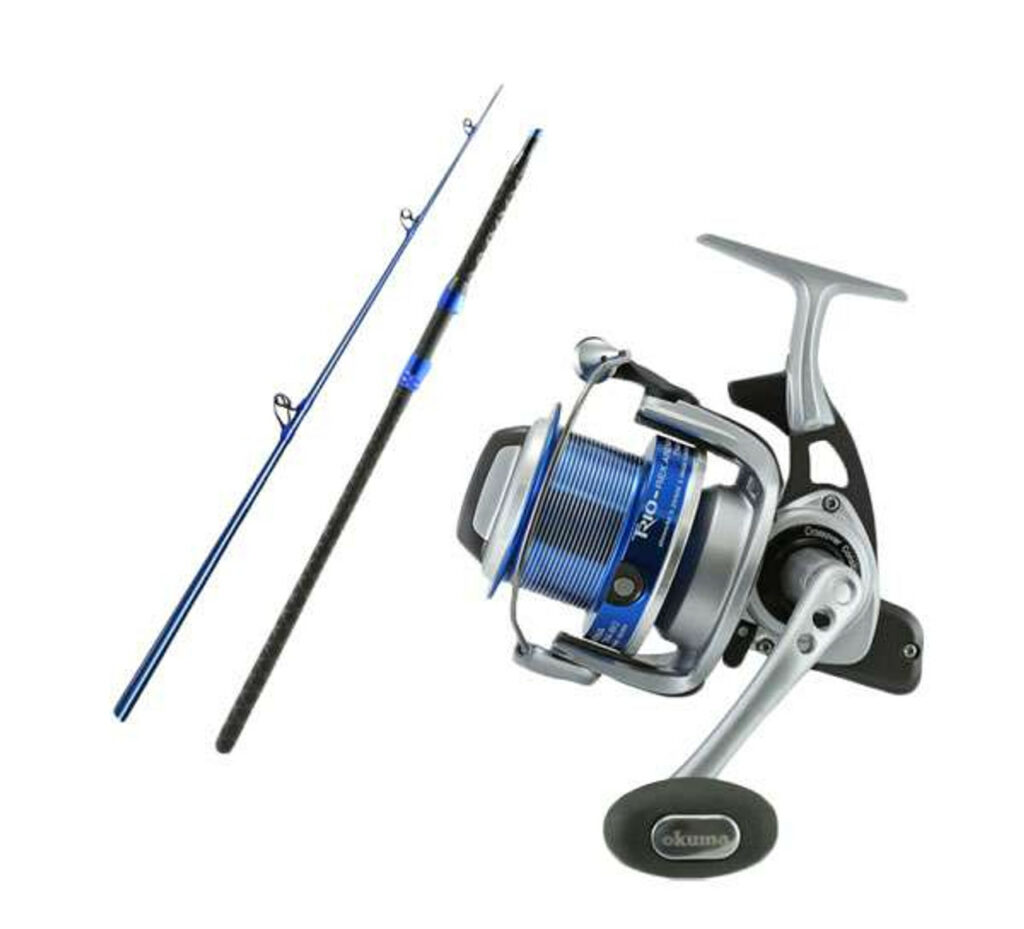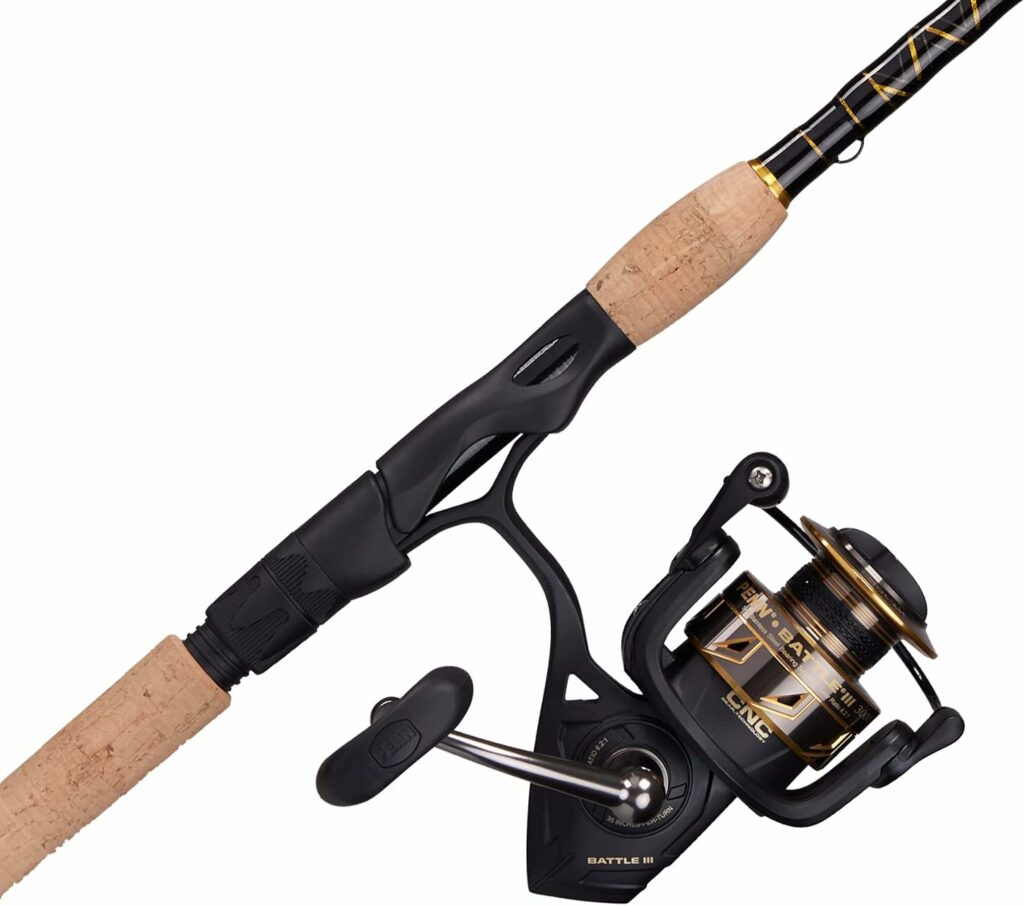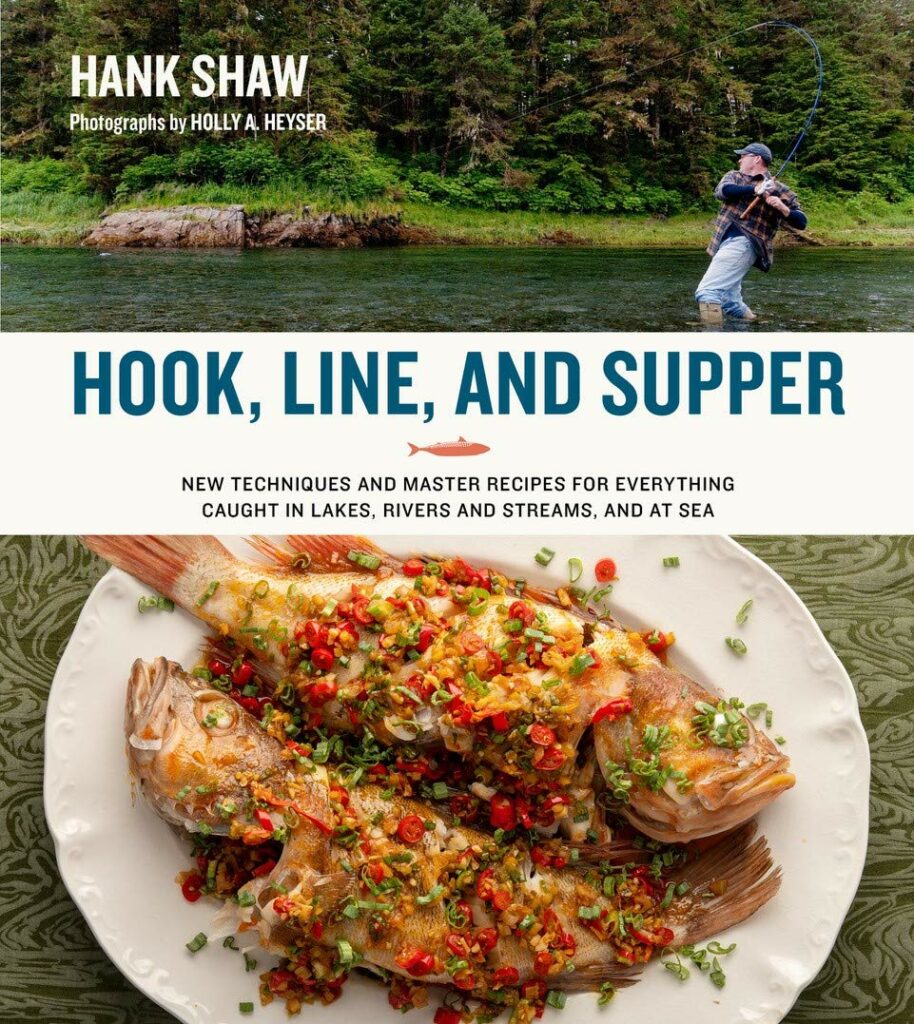Continuing with our look for alternative or underutilized fish, to take the pressure off the more popular gamefish. Let’s take a Look at surf fishing for bluefish. Bluefish are known for their aggressive behavior, powerful strikes, and fierce fights, making them a favorite among sport fishermen. Whether you’re a beginner or an experienced angler, surf fishing for bluefish offers a unique and rewarding experience.
KEY POINTS:
5 Best Baits and Lures for Catching Bluefish in the Surf:
- Metal Spoons: Silver or chrome-colored spoons imitate the flash of baitfish and can be retrieved at various speeds to entice bluefish strikes.
- Topwater Plugs: Surface plugs such as poppers and walking baits create a commotion on the water’s surface, mimicking injured baitfish.
- Soft Plastic Swimbaits: Paddle-tail or curly-tail soft plastics in bright colors rigged on a jig head can be retrieved at different speeds to imitate wounded baitfish making them irresistible to bluefish.
- Cut Bait: Fresh chunks or strips of baitfish like bunker, mullet, or mackerel can attract bluefish with their scent.
- Live Bait: When available, live bait such as eels, menhaden, bunker, or mullet can be highly effective.
Bluefish, also known as gator or snapper blues, are popular among surf fisherman along the Atlantic and gulf coasts. And, depending on who you talk too, may or may not be considered good table fare. More on that issue later, but for now, lets dive into the world of surf fishing for bluefish.
We’ll explore everything you need to know about surf fishing for bluefish, from the equipment you’ll need to the best techniques, strategies, expert tips, and how to choose the best locations for catching bluefish in the surf. Of course, first things first, we need to learn about bluefish and their behavior to better understand how to find and catch them.
Understanding Bluefish and Their Behavior
Before diving into the tips and techniques of surf fishing for bluefish, it’s essential to understand their behavior. Understanding their feeding patterns and preferred habitats will increase your chances of finding and catching fish.
Bluefish, scientifically known as Pomatomus saltatrix, are highly migratory predatory fish found around the world in temperate and subtropical waters, except for the northern Pacific Ocean. They are known as tailor in Australia and New Zealand, elf and shad in South Africa. Bluefish are both a popular gamefish and food fish.
They are characterized by their slender bodies, bluish-green coloration dorsally, fading to white on the lower sides and belly, and a mouthful of razor-sharp teeth. Bluefish are known for their voracious feeding habits and range in size from seven-inch (18-cm) “snappers” to much larger, sometimes weighing as much as 40 lb (18 kg), though fish heavier than 20 lb (9 kg) are exceptional.
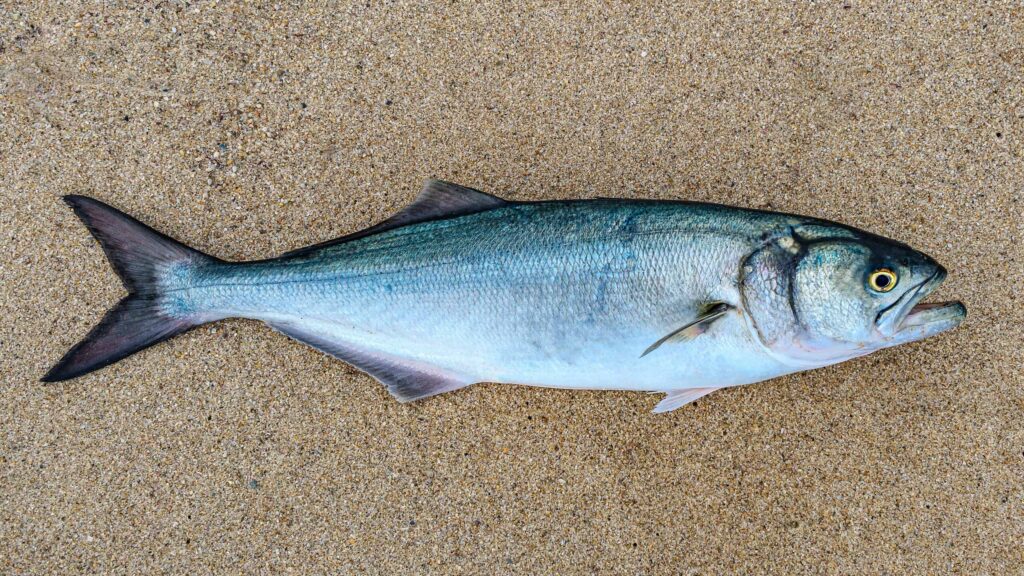
Bluefish are voracious predators known for their aggressive feeding habits. They tend to school in large numbers, often creating a feeding frenzy when they encounter baitfish. They are one of the most well-equipped predators in the surf. Armed with a very sharp set of teeth, they use their keen hearing and eyesight not to grab a hold of bait, but to chop it biting chunks out of a baitfish.
During a bluefish feeding frenzy you’ll see baitfish jumping out of the water and even beaching themselves trying to escape from getting chopped and eaten. If you happen to come across one of these feeding frenzies, it can be an absolute blast. You can throw pretty much anything in your tackle box and frenzied bluefish will attack it.
Bluefish run on the small side along the Gulf Coast states, usually averaging less than 3 pounds. However, they can get rather large in the Northeast, where they regularly catch fish in the 15 lbs range. The world record is 31 lbs. 12 oz, taken from Hatteras, North Carolina.
Bluefish Range
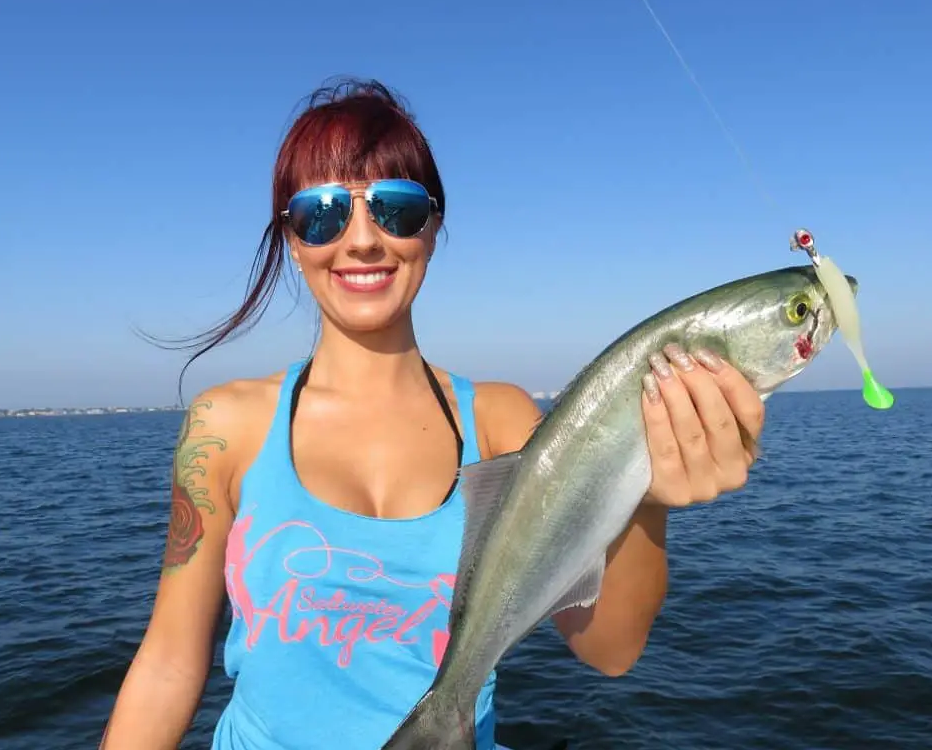
Bluefish are widely distributed around the world in tropical and subtropical waters. They are found in pelagic waters on much of the continental shelves along eastern America, Africa, the Mediterranean and Black Seas, Southeast Asia, and Australia.
In the US, Bluefish are found all along the Gulf, from Texas to Louisiana and Florida, but more prolifically up and down the Atlantic coast, from Florida to New England. In summer, they are one of the most common species caught in the surf, from North Carolina to Maine.
The largest blues are mostly caught in the northern part of their Atlantic range, from Maryland to Massachusetts. Along most of the Gulf coast, bluefish are not often specifically targeted, as the runs of larger bluefish are less frequent or predictable.
Bluefish Migration
Bluefish are known to be migratory species, often found along the Atlantic coast during warmer months. They prefer water temperatures between 60°F and 75°F (15°C to 24°C) and are commonly found in areas with abundant baitfish populations.
Bluefish are commonly caught in the Northeast from spring through fall, by October they will begin to migrate south, as the water cools down. They are found off Florida in the winter, but as the waters warm in the spring and summer, they begin to migrate back north by April, and can be found off Massachusetts by June.
Surf Fishing for Bluefish Essential Gear
To get started with surf fishing for bluefish, you’ll need surf fishing gear. Having the right tackle will increase your chances of having a successful trip. Here is a list of essential equipment you’ll need:
Surf Fishing Rod: Choose a sturdy, 9 to 12-foot rod with medium to heavy action to handle the weight and fight of bluefish.
Spinning Reel: Choose a spinning reel that can hold at least 200 yards of 15 to 20-pound test monofilament or braided line.
Fishing Line: Monofilament or braided lines are commonly used for surf fishing. They offer strength, durability, and good casting distance. Opt for a strong and abrasion-resistant monofilament or braided fishing line with a test strength of at least 20 pounds. Bluefish have sharp teeth that can easily cut through weaker lines.
Terminal Tackle: Include a selection of sinkers, hooks, swivels, and leaders in various sizes to adapt to different fishing conditions. Include a variety of hooks, sinkers, swivels, and leaders in your tackle box. Bluefish have a tendency to bite through leaders, so using a wire or heavy fluorocarbon leader is advisable.
Essential Surf Fishing Gear:
- Surf Fishing Rods, surf rods are typically longer and heavier duty than standard rods. – read more.
- Surf fishing Reels,larger and stronger with greater line capacity to handle big fish. – read more.
- Surf fishing Rod and Reel Combos, pre-matched rod and reel set ups for surf fishing – read more.
- Sand Spike Rod holder, holds your rods securely while you wait for that big bite. – read more.
- Surf Fishing Rigs, terminal tackle for fishing the surf. – read more.
- Surf fishing Carts, for beaches that won’t allow vehicles you need a way to carry your gear – read more.
- Rod Racks for Vehicles, carry your rods out of harms way and easy to access- read more.
- Beach Camping Gear, in case you want to fish all night or for several days – read more.
Bait and Lures: Bluefish are known to be aggressive feeders, so a variety of lures such as spoons, plugs, and soft plastics can be effective. However, you’ll go through a lot of soft plastics as the teeth of bluefish make short work of them. Additionally, fresh bait like bunker, mullet, or cut fish can entice bluefish to strike. Bluefish are attracted to a wide range of lures and baits. Popular choices include metal spoons, topwater plugs, soft plastic baits, and fresh baitfish such as bunker or mullet.

Fishing Accessories: Don’t forget to bring items like tackle box or backpack, filet knife, pliers, fish gripper, sunscreen, hat, sunglasses, and a cooler to keep your catch fresh.
Remember to check your gear regularly for any signs of wear and tear and replace any damaged or nicked leaders or line.
Surf Fishing for Bluefish Bait and Lure Selection
Bluefish are aggressive feeders and will strike a variety of natural and artificial baits. Here are some effective bait and lure options for bluefish:
- Metal Spoons: Silver or chrome-colored spoons imitate the flash of baitfish and can be retrieved at various speeds to entice bluefish strikes.
- Topwater Plugs: Surface plugs such as poppers and walking baits create a commotion on the water’s surface, mimicking injured baitfish. Bluefish often react to the splashes and vibrations, resulting in explosive strikes.
- Soft Plastic Swimbaits: Paddle-tail or curly-tail soft plastics in bright colors rigged on a jig head can be retrieved at different speeds to imitate wounded baitfish making them irresistible to bluefish. But they will not last long with those teeth.
- Cut Bait: Fresh chunks or strips of baitfish like bunker, mullet, or mackerel can attract bluefish with their scent. Use a fish finder rig or a Carolina rig to present the bait near the bottom.
- Live Bait: When available, live bait such as eels, menhaden, bunker, or mullet can be highly effective. Rig them on a fish finder rig or a float rig to keep them at the desired depth.
Good Artificial Lures for Bluefish
Remember to experiment with different baits and lures to determine what works best in your fishing location and conditions as bluefish feeding preferences can vary from day to day and season to season.
Best Times for Surf Fishing for Bluefish
Timing plays a crucial role in surf fishing for bluefish. They are most active during the warmer months, typically from late spring to early fall. It’s usually during the Spring and Fall migrations that offer the best surf fishing for bluefish. This is when large schools come in close to shore to feed heavily on migrating baitfish such as anchovies, menhaden or mullet.
Early mornings and evenings tend to be the best times to target bluefish, as they are more active during low-light conditions.
However, bluefish can be caught throughout the day, especially during periods of high tidal movement or when schools of baitfish are present.
Bluefish are a warm water species and they typically do best when the water temp is in the upper 50°-80°. As the water temp changes during the seasons, bluefish tend to follow the warm water. During the cold months, bluefish migrate south. When the water heats back up, bluefish move north.
Tides and Moon Phases
Tides and moon phases can significantly impact bluefish feeding behavior. Here’s how to leverage these factors to your advantage:
Incoming Tide: Bluefish are known to be more active during incoming tides. As the tide rises, it brings baitfish closer to shore, attracting hungry bluefish looking for an easy meal.
Outgoing Tide: While bluefish can still be caught during the outgoing tide, their feeding activity tends to slow down. Focus your efforts on the beginning and end of the outgoing tide when water movement is still present.
Moon Phases: Bluefish feeding patterns are influenced by moon phases. During the new moon and full moon, tidal movement is more pronounced, leading to increased feeding activity. Plan your fishing trips around these moon phases for the best chances of success.
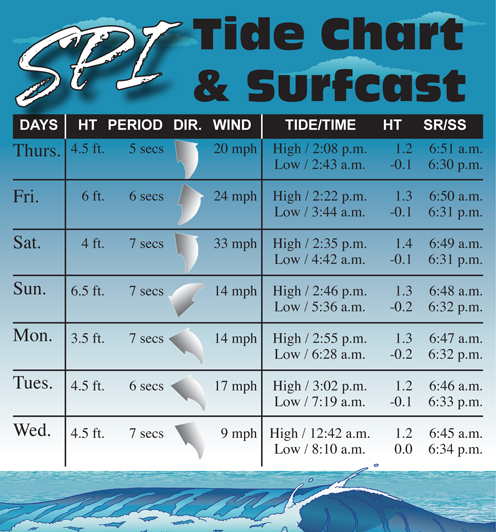
Keep a tide chart and moon phase calendar handy to help you schedule your surf fishing trips during optimal periods.
Surf Fishing for Bluefish: Finding the Right Spot
Reading the Surf for Bluefish
Understanding how to read the surf will help you identify areas most likely to hold fish. Here are some key factors to consider:
- Wave Action: Look for areas where waves are breaking, creating whitewater and turbulence. Bluefish often patrol these areas, searching for disoriented or injured baitfish.
- Color Changes: Pay attention to changes in water color. Bluefish are often found where clear water meets murkier or choppier water, as this is where baitfish are likely to gather.
- Structure: Sandbars and troughs are underwater formations parallel to the shore. Jetties, rock formations, or troughs. These structures provide hiding places for baitfish, attracting bluefish. Bluefish often use these structures as highways, so focus your fishing efforts around these areas.
- Rip Currents: Rip currents occur when water rushes back to the sea through a narrow channel. These currents concentrate baitfish and attract predators like bluefish.
- Bird and or Baitfish Activity: Keep an eye on seagulls and other diving birds. They are excellent indicators of baitfish schools and can lead you to bluefish feeding frenzies.
- Local Knowledge: Seek advice from local anglers, bait shops, local fishing reports or fishing forums to gather information about productive fishing spots in the area.
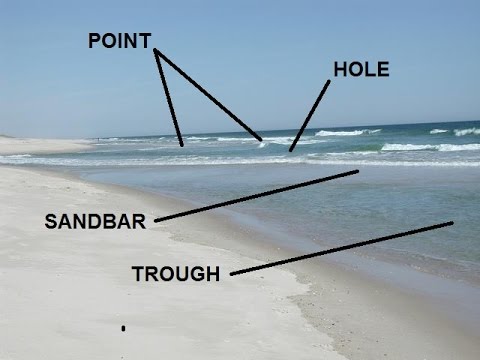
By observing these surf conditions, you can determine where bluefish are likely to be hunting and position yourself for optimal fishing opportunities. In short, to find schools of bluefish, find the schools of baitfish.
Look for points along the beach or a cut in a sandbar where bluefish can more easily ambush and corral a school of baitfish.
An incoming tide often brings baitfish into the trough along the beach, offering bluefish a great opportunity to push them up against the beach. Look for beach structures such as a point, a jetty, a sandbar, and always be on the lookout for birds or commotion on the surface.
An escaping school of bait fish cannot go beyond the surface, so they are often pushed upwards by bluefish. If you see a school of bait fish jumping, know that something is trying to eat them. If you see birds hovering over the water and making dives, there’s probably a school of baitfish being eaten beneath them.
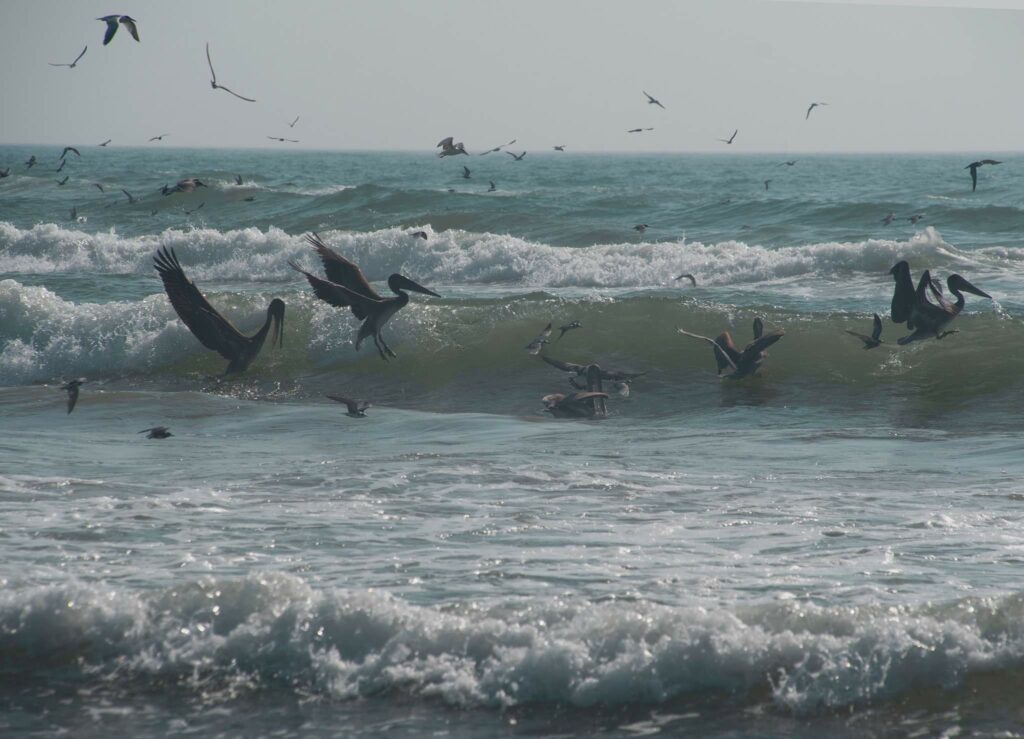
And, that would be a great spot to fish with bait or lures. Artificials that closely imitate those jumping bait fish are likely to get hammered by aggressive bluefish. Or, any number of other predators that are getting in on the frenzy.
Catching and Handling Bluefish
Catching bluefish can be some fast and furious action, but in all the excitement, it’s important to handle them properly to ensure their survival and the survival of your fingers.
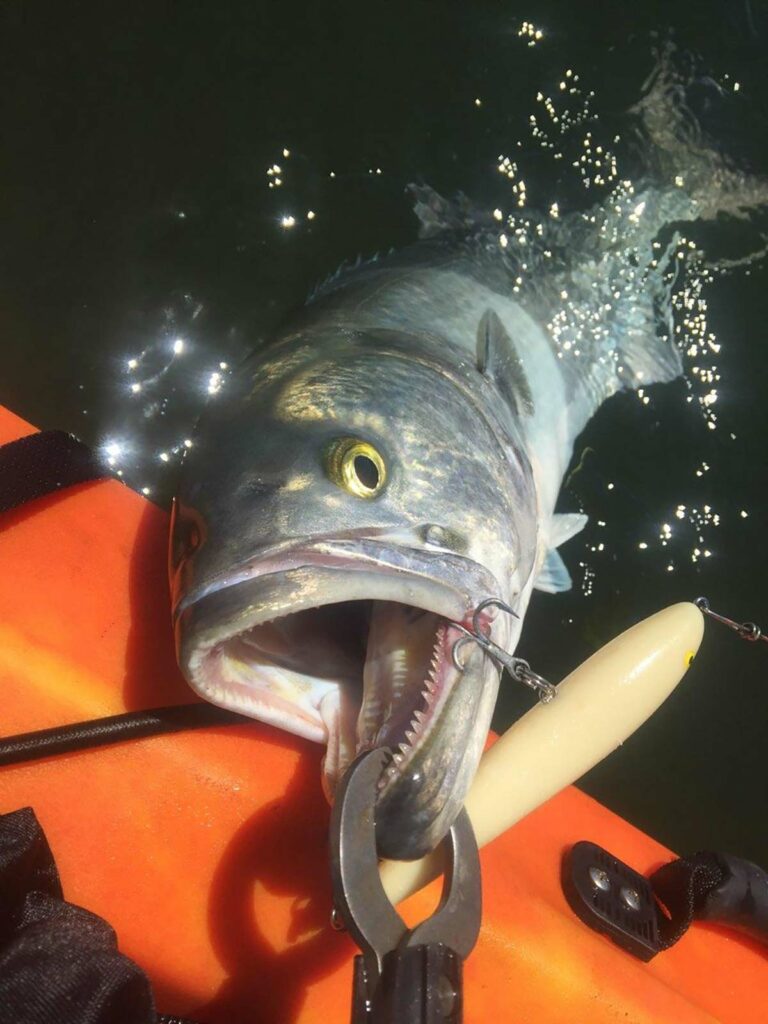
- Use a Landing Net or fish grips: When reeling in a bluefish, use a landing net to bring it safely onto the shore or into your boat. This prevents damage to the fish and reduces the risk of getting bitten by their sharp teeth.
- Avoid Touching the Gills: Bluefish have sharp gill plates that can cause cuts or punctures. Instead, hold them firmly by the lower jaw or use a fish gripper to handle them.
- Remove the Hook Carefully: Use a pair of long-nose pliers or a dehooking tool to remove the hook. If the fish has swallowed the hook deeply, it’s best to cut the line as close to the hook as possible to avoid causing internal injuries. Bluefish are often released, so minimizing harm is crucial for their survival.
- Revive and Release: If you’re releasing the bluefish, hold it upright in the water and gently move it back and forth to allow water to pass over its gills. This helps to revive the fish and ensures its successful release.
Cleaning and Cooking Bluefish
Bluefish are delicious when prepared fresh, and there are several cooking methods you can try. Before cooking, it’s essential to clean the fish properly.
The best recommendation is to bleed the fish by cutting the gills. This will help reduce the “fishy” taste in the meat.
- Rinse the bluefish with cold water to remove any sand or debris.
- Make a deep incision behind the gills, cutting down to the backbone.
- Insert your fingers into the incision and run them along the backbone, separating the fillet from the bones.
- Repeat the process on the other side of the fish.
- Remove the rib bones by cutting along the ribcage.
- Trim any dark red or fatty areas from the fillets. This is usually located along the lateral line and next to the skin. A thin bladed filet knife can make quick work of trimming this red meat away.
- Rinse the fillets once more and pat them dry with a paper towel.
Now that the bluefish is cleaned, you can proceed with various cooking methods such as grilling, baking, broiling, or pan-searing. Bluefish has a rich flavor, and its firm, moist flesh pairs well with a variety of seasonings and marinades. Experiment with different recipes to find your favorite way to enjoy this delectable fish.
Baked Bluefish
credit: simplyrecipies.com
Ingredients
- 1 (1/2- to 1-pound) bluefish fillet
- Kosher salt
- Freshly ground black pepper
- 3 to 5 very thin slices fresh lemon
- 3 pats butter (about 1 teaspoon each)
- Several sprigs fresh herbs such as tarragon, thyme, fennel fronds, and/or parsley (or 1 teaspoon dried herbs such as Italian seasoning or herbes de Provence)
- 3 tablespoons dry white wine
- 2 tablespoons lemon juice
Directions
- Preheat oven to 350°F.
- Place fillet skin-side down in foil-lined-roasting pan: Cut a piece of foil large enough to enclose the bluefish fillet. (You can double layer the foil if you are working with thin foil).
- Place the foil in a roasting pan. Rinse the bluefish fillet and place it in the center of the foil, skin side down.
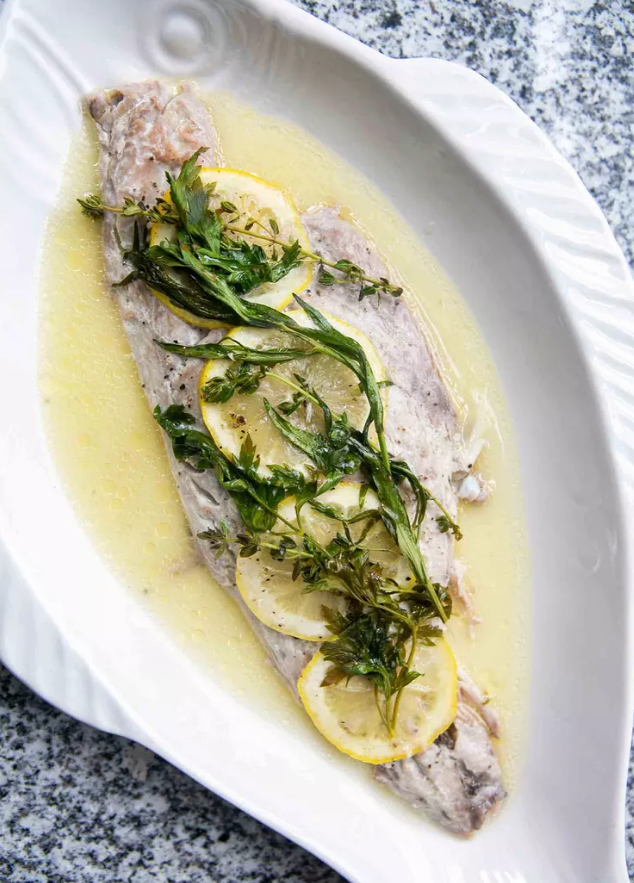
- Add white wine and lemon juice, seal foil packet: Create a boat shape with the foil around the fish so that liquid does not leak out. Pour white wine over the fish, and sprinkle with the lemon juice. Crimp the edges of the foil together so they are relatively sealed.
- Bake: Place in the 350°F oven (or you can put the foil packet on the grill) and bake for 15 to 20 minutes or so, until the fish is cooked through and opaque.
- Serve: Carefully lift the fillet from the foil and place on a serving dish. Pour the cooking liquid over the fish to serve.
Fast Vietnamese Caramel Bluefish
Credit: cooking.nytimes.com

INGREDIENTS
- 4(6-ounce) skin-on bluefish fillets (or substitute mackerel, trout or thin salmon fillets)
- 1tablespoon peanut, grapeseed or safflower oil
- 1stalk lemongrass, or use lemon or lime zest (see note)
- ⅓cup light brown sugar
- 2tablespoons Asian fish sauce
- 1½tablespoons soy sauce
- 1teaspoon grated ginger
- ½teaspoon black pepper
- Sliced scallions, as needed
- Thinly sliced jalapeño, as needed
- Fresh cilantro, as needed
- Cooked rice, for serving (optional)
PREPARATION
Step 1: Brush fish all over with oil. Remove outer layer of lemongrass stalk and cut stalk into 2-inch lengths. Using the butt of a kitchen knife, pound and bruise stalks all over.
Step 2: Place lemongrass pieces, sugar, fish sauce, soy sauce, ginger and black pepper in a large skillet. Bring to a simmer over medium-high heat, and reduce sauce for 1 to 2 minutes, until syrupy.
Step 3: Place fish, skin side-down, in pan. Simmer, basting fish frequently with pan sauce, for 2 minutes; carefully turn fish and continue cooking until fish is just cooked through, 2 to 3 minutes longer.
Step 4: Transfer fish to a serving plate and garnish with scallion, jalapeño and cilantro. Drizzle with additional sauce. Serve over rice, if desired. Yield:4 servings
TIP: If you can’t get lemongrass, peel a 2-inch strip of lemon or lime zest with a peeler and use that instead. You don’t need to bruise the peel.
Conservation and Responsible Fishing
Responsible fishing practices are crucial to preserving the bluefish population and the overall health of marine ecosystems. Here are some guidelines to follow:
- Observe Size and Bag Limits: Familiarize yourself with the local regulations regarding size limits and bag limits for bluefish. Respect these limits to ensure sustainable fishing.
- Practice Catch and Release: Consider releasing larger bluefish, as they are often breeding females that contribute to the species’ reproduction.
- Avoid Overfishing Areas: If you notice a significant decline in bluefish populations or receive reports of overfishing in certain areas, consider exploring alternative fishing spots to reduce pressure on the population.
- Dispose of Waste Properly: Always dispose of fishing line, hooks, and other waste in designated receptacles. This prevents entanglement hazards for marine life.
By adopting responsible fishing practices, we can help conserve bluefish populations for future generations of anglers to enjoy.
Surf Fishing for Bluefish Frequently Asked Questions
What is the best bait for bluefish?
Bluefish are attracted to fresh baitfish such as bunker or mullet. Metal spoons and topwater plugs are also effective lures.
Are bluefish aggressive?
Bluefish are known for their aggressive feeding behavior and powerful strikes. They are often sought after by anglers who enjoy the excitement of reeling in these fierce fighters.

Do I need a fishing license for surf fishing?
Yes, a fishing license is generally required for surf fishing, unless you are exempt due to age or other specific circumstances. It’s essential to check the fishing regulations of the specific area where you plan to fish to ensure compliance with the local rules.
What other fish can I catch while surf fishing for bluefish?
While targeting bluefish, you may also encounter other popular surf species such as striped bass, flounder, weakfish, red drum, and black drum. These fish are often found in similar areas and can provide additional excitement and variety to your surf fishing experience
Can I eat bluefish?
Yes, bluefish is a popular and delicious fish to eat. However, it is important to note that larger bluefish can have a stronger flavor. Many anglers prefer to consume smaller bluefish (around 2 to 5 pounds) for a milder taste. Properly cleaning and cooking the bluefish can also help enhance its flavor. Bluefish are delicious when cooked properly. Their rich flavor and moist flesh make them a popular choice among seafood enthusiasts
What is the bag limit for bluefish?
Bag limits and fishing regulations for bluefish can vary depending on the state and fishing location. It is crucial to check the local fishing regulations and bag limits to ensure compliance with the specific rules in your area. These regulations are put in place to protect the fishery and ensure its sustainability for future generations.
Is surf fishing for bluefish suitable for beginners?
Yes, surf fishing for bluefish can be a great activity for beginners. Bluefish are known for their aggressive strikes, making them exciting to catch. With the right gear, basic casting skills, and some knowledge about bluefish behavior, beginners can have a rewarding experience targeting these fish from the surf.
Get Out There and Try Surf Fishing for Bluefish
Bluefish have gotten a bad rap in some circles as not being good to eat, or “too bloody” or “too fishy”. However, keep them cold and on ice until ready to filet, then clean them correctly by removing the dark red meat along the lateral line and next to the skin, you will actually have some great eating fish. I know, I’ve done it more than once in my half century of surf fishing for bluefish and gafftopsail catfish among others. Of course, they are great sport if you just want to catch and release as well.
More importantly, surf fishing for bluefish is an exciting experience for both beginners and seasoned anglers. From the excitement of their aggressive strikes to their powerful arm straining fights, bluefish provide for some memorable fishing adventures.
By using the proper equipment, choosing the right location, and using effective baits and lures, you can increase your chances of success.
Remember to always respect your local fishing regulations, and handle all fish with care, if you are going to be releasing them, to ensure a sustainable fishery for future generations to enjoy.
So grab your gear, head to the beach, and get ready for an unforgettable adventure surf fishing for bluefish.
As always, stay safe, enjoy the journey and please try to leave it cleaner than you found it. If you have any comments, questions, ideas or suggestions please leave them in the comment section below and I’ll get back to you asap.

You can follow us on Facebook: Rex The Beach Angler, Instagram: thebeachangler7, Twitter: @AnglerBeach, and YouTube: Man Art Creations.
P.S. – Thanks so much for checking out our blog we really appreciate it. Just so you know, we may receive a commission if you click on some of the links that appear on our site. This helps us keep our content free and up-to-date for everyone. We appreciate your support!
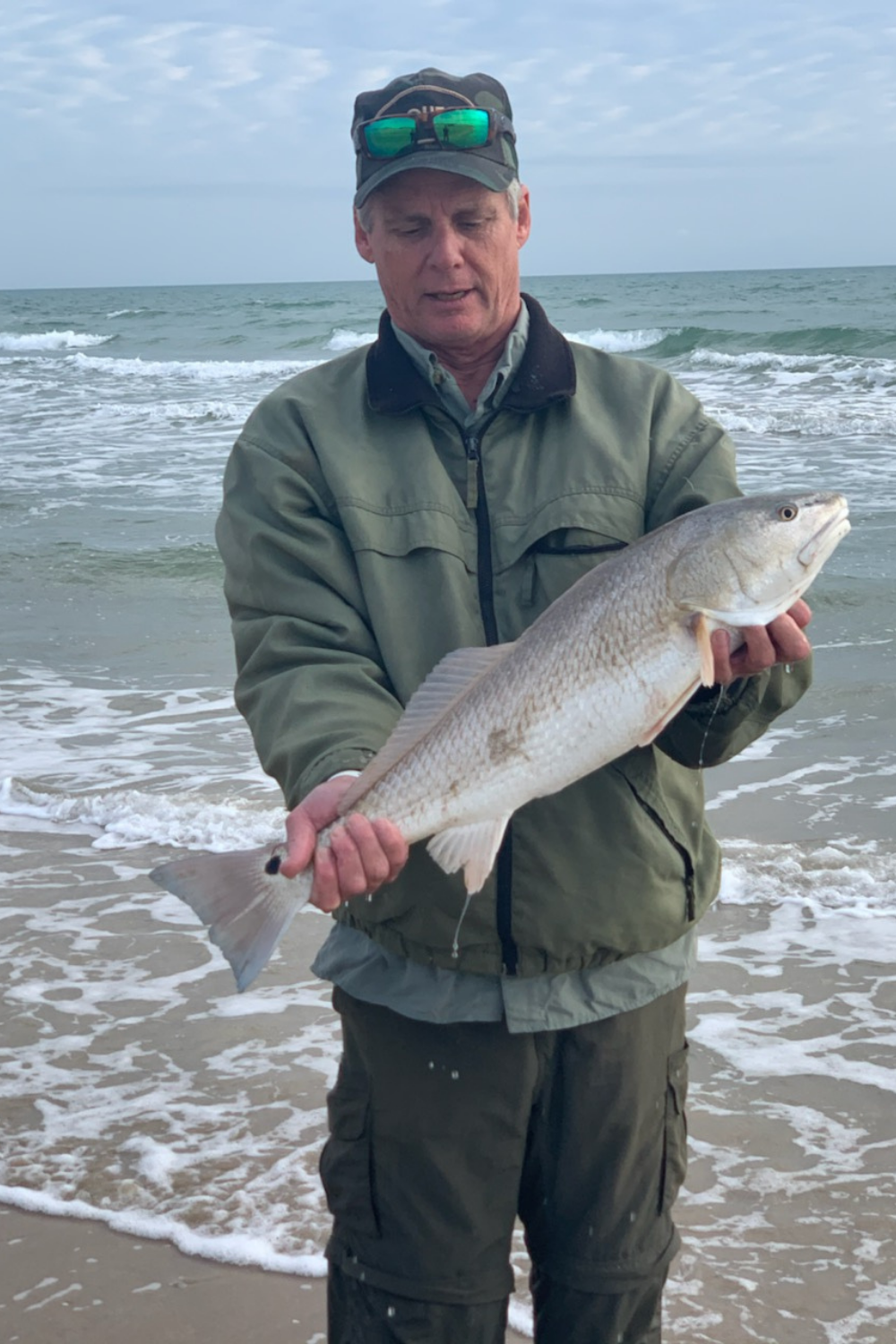
A life long surf fisherman with 50+ years of experience, I am also an avid hunter and outdoorsman. I will be sharing my passion for the outdoors with you so be prepared for hunting, fishing, camping, hiking and more. Along with gear reviews and the latest trends and innovations in the outdoor industry.
